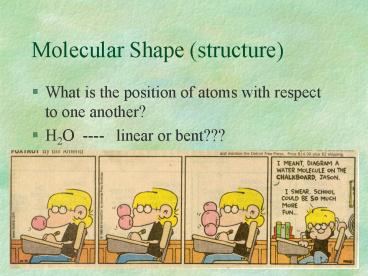Molecular Shape structure - PowerPoint PPT Presentation
1 / 45
Title:
Molecular Shape structure
Description:
Molecular Shape (structure) What is the position of atoms with respect to one another? ... describe the molecular geometry in terms of the arrangement of the ... – PowerPoint PPT presentation
Number of Views:1133
Avg rating:3.0/5.0
Title: Molecular Shape structure
1
Molecular Shape (structure)
- What is the position of atoms with respect to one
another? - H2O ---- linear or bent???
2
Definitions
- Valence shell - highest s and p electrons past an
inert gas configuration - electron pairs
- bonded pairs - make up a covalent bond
- lone pair - are non-bonded (not shared)
- central atom - the atom at the center of the
molecule - ligand - atoms attached to the central atom
3
Valence Shell Electron Pair Repulsion Theory
- VSPER
- geometry about the central atom is determined by
- the repulsive interactions between electron pairs
(both shared and unshared) - these pairs want to maximize their distance apart
- electron pairs want to avoid each other!
4
(No Transcript)
5
Determining Geometry
- Steps for determining molecules geometry
- draw Lewis Dot structure
- count total number of electron pairs surrounding
the central atom. Arrange them to minimize
electron shell repulsion - describe the molecular geometry in terms of the
arrangement of the bonding pairs - consider specifics of the bond angles involved
- Double and triple bonds are counted as one
bonded pair for structure determination
6
VESPR cont.
- Gillespie notation
- AXmEn
- A represents the central atom
- X represents a ligand (bonded electrons)
- E represent the non-bonded electron pairs
7
VSPER
Number of Electron Pairs
180
Number of Electron Pairs
2
90
Linear
5
120
120
3
Trigonal Bipryamidal
Trigonal Planar
90
90
6
109.5
4
Octahedral
Tetrahedral
8
Trigonal Planar
lt 120
120
AX3
AX2E
trigonal planar
bent, angular
9
Tetrahedral
lt 109.5 (104.5)
lt 109.5 (107)
109.5
AX4
AX3E
AX2E2
Tetrahedral
Trigonal pyramidal
Bent
NH3
H2O
10
Trigonal Bipyramidal
90
lt90
lt90
120
lt 120
AX5
AX4E
AX3E2
AX2E3
See Saw Irregular tetrahedron
Trigonal pyramidal
T-shaped
Linear
PCl5
SF4
BrF3
ICl2-
11
Octahedral
90
lt90
90
90
90
AX6
AX5E
AX4E2
Octahedral
Square Pyramidal
Square Planar
SF6
BrF5
XeF4
12
(No Transcript)
13
Bond Angles
- Electron - electron repulsion
- LP-LP gt LP-BP gt BP-BP
- LP lone pair
- BP bonded pair
- CH4 vs NH3 vs H2O
- double or triple bonds repel more strongly than
single bonds - F2CO
- SO3
14
Pop Quiz 4
15
Check-in
- 1.) Before you begin this check-in, you will
need to draw the Lewis structures of PF5 and
IF5. The central atom is underlined. What is
common property do the central atoms display as
compared to their ligands? - 2.) How many valence electrons are there in the
Lewis structure for IF5 and PF5? - 3.) How many total electrons, including all of
the core electrons, are there in a molecule of
IF5 and there in a molecule of PF5? - 4.) Using VSEPR theory, determine the molecular
shape of PF5. - 5.) Based on your Lewis structures and the
information you provided above, do you expect IF5
to have the same molecular structure as PF5 or a
different structure? Why? If you think the
molecular structures are different, how would you
describe the structure of IF5?
16
Problems
- 10.38, 10.48, 10.64,10.70
17
Electronegativity and Polarity in molecules
- NaCl vs Cl-Cl
- most molecules are in between these two extremes
- atoms with a higher ionization energy and greater
affinity for electrons will attract bonding
electrons more - Electronegativity - a measure of the atoms
attraction of an electron pair
18
Electronegativity
19
What is happening as we move across the periodic
table?
20
as we continue?
21
Covalent Bonding Sharing Electrons
22
Electronegativity and Polarity in molecules
- Polar bond - the unequal sharing of an electron
pair - Greater electronegativity difference between
atoms, the more polar the bond - Dipole moment
- use molecular shape and the individual bond
polarities to determine the total polarity of the
molecule
23
Molecule Polar or Non-Polar? . and, if it
has one, what is the direction of the dipole
moment?
- CCl4
- H2O
24
Molecular Shape and the Greenhouse Effect
- From Chemistry The Science in Context, Gilbert
et al. p. 335-339
25
- From Chemistry The Science in Context, Gilbert
et al. p. 335-339
26
- From Chemistry The Science in Context, Gilbert
et al. p. 335-339
27
- From Chemistry The Science in Context, Gilbert
et al. p. 335-339
28
Changes in Average Global Temperature
- From Chemistry The Science in Context, Gilbert
et al. p. 335-339
29
- From Chemistry The Science in Context, Gilbert
et al. p. 335-339
30
- From Chemistry The Science in Context, Gilbert
et al. p. 335-339
31
Valence bond theory model of the covalent bond
- Covalent bonds result from the overlap of atomic
orbitals on adjacent bonds
32
- But this doesnt always work
- H2O
- experiment and VSEPR theory say bent (lt109.5?)
- this simplistic atomic orbital idea suggests a
bond angle of lt90?
33
Hybrid orbitals
- Alternative ways to describe the atomic orbital
wave functions - also satisfy the Schrodinger equation
34
(No Transcript)
35
(No Transcript)
36
(No Transcript)
37
Composition and Orientation of Hybrid Orbital
38
Complete Valence Bond Description
- Determine Lewis Dot Structure
- Predict Geometry (Molecular shape and electron
group arrangement) - Assign hybridization
- Describe bonding in terms of overlap sigma (?)
versus pi (?) bonding
39
Example Problems Determine Complete Valence
Bond Description
- BF3
- C2H6
- C2H4
- C2H2
40
C2H6
41
C2H4
42
C2H2
43
VSEPR Handouts
44
(No Transcript)
45
(No Transcript)































